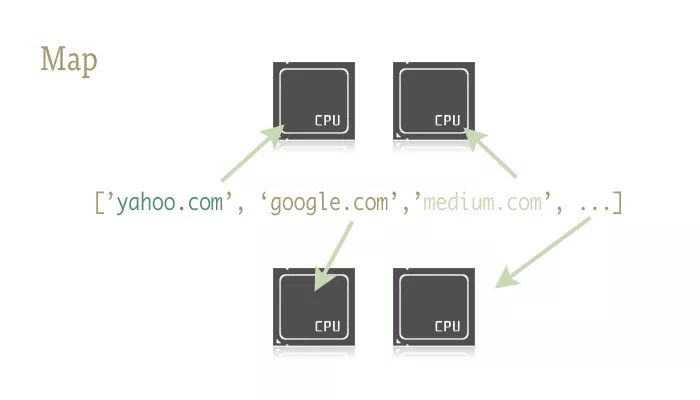
Python 在程序并行化方面多少有些声名狼藉。撇开技术上的问题,例如线程的实现和 GIL,我觉得错误的教学指导才是主要问题。常见的经典 Python 多线程、多进程教程多显得偏"重"。而且往往隔靴搔痒,没有深入探讨日常工作中最有用的内容。
传统的例子
简单搜索下"Python 多线程教程",不难发现几乎所有的教程都给出涉及类和队列的例子:
import os
import PIL
from multiprocessing import Pool
from PIL import Image
SIZE = (75,75)
SAVE_DIRECTORY = 'thumbs'
def get_image_paths(folder):
return (os.path.join(folder, f)
for f in os.listdir(folder)
if 'jpeg' in f)
def create_thumbnail(filename):
im = Image.open(filename)
im.thumbnail(SIZE, Image.ANTIALIAS)
base, fname = os.path.split(filename)
save_path = os.path.join(base, SAVE_DIRECTORY, fname)
im.save(save_path)
if __name__ == '__main__':
folder = os.path.abspath(
'11_18_2013_R000_IQM_Big_Sur_Mon__e10d1958e7b766c3e840')
os.mkdir(os.path.join(folder, SAVE_DIRECTORY))
images = get_image_paths(folder)
pool = Pool()
pool.map(creat_thumbnail, images)
pool.close()
pool.join()
哈,看起来有些像 Java 不是吗?
我并不是说使用生产者/消费者模型处理多线程/多进程任务是错误的(事实上,这一模型自有其用武之地)。只是,处理日常脚本任务时我们可以使用更有效率的模型。
问题在于…
首先,你需要一个样板类;
其次,你需要一个队列来传递对象;
而且,你还需要在通道两端都构建相应的方法来协助其工作(如果需想要进行双向通信或是保存结果还需要再引入一个队列)。
worker 越多,问题越多
按照这一思路,你现在需要一个 worker 线程的线程池。下面是一篇 IBM 经典教程中的例子——在进行网页检索时通过多线程进行加速。
#Example2.py
'''
A more realistic thread pool example
'''
import time
import threading
import Queue
import urllib2
class Consumer(threading.Thread):
def __init__(self, queue):
threading.Thread.__init__(self)
self._queue = queue
def run(self):
while True:
content = self._queue.get()
if isinstance(content, str) and content == 'quit':
break
response = urllib2.urlopen(content)
print 'Bye byes!'
def Producer():
urls = [
'http://www.python.org', 'http://www.yahoo.com'
'http://www.scala.org', 'http://www.google.com'
# etc..
]
queue = Queue.Queue()
worker_threads = build_worker_pool(queue, 4)
start_time = time.time()
# Add the urls to process
for url in urls:
queue.put(url)
# Add the poison pillv
for worker in worker_threads:
queue.put('quit')
for worker in worker_threads:
worker.join()
print 'Done! Time taken: {}'.format(time.time() - start_time)
def build_worker_pool(queue, size):
workers = []
for _ in range(size):
worker = Consumer(queue)
worker.start()
workers.append(worker)
return workers
if __name__ == '__main__':
Producer()
这段代码能正确的运行,但仔细看看我们需要做些什么:构造不同的方法、追踪一系列的线程,还有为了解决恼人的死锁问题,我们需要进行一系列的 join 操作。这还只是开始……
至此我们回顾了经典的多线程教程,多少有些空洞不是吗?样板化而且易出错,这样事倍功半的风格显然不那么适合日常使用,好在我们还有更好的方法。
何不试试 map
map 这一小巧精致的函数是简捷实现 Python 程序并行化的关键。map 源于 Lisp 这类函数式编程语言。它可以通过一个序列实现两个函数之间的映射。
urls = ['http://www.yahoo.com', 'http://www.reddit.com']
results = map(urllib2.urlopen, urls)
上面的这两行代码将 urls 这一序列中的每个元素作为参数传递到 urlopen 方法中,并将所有结果保存到 results 这一列表中。其结果大致相当于:
results = []
for url in urls:
results.append(urllib2.urlopen(url))
map 函数一手包办了序列操作、参数传递和结果保存等一系列的操作。
为什么这很重要呢?这是因为借助正确的库,map 可以轻松实现并行化操作。

在 Python 中有个两个库包含了 map 函数:multiprocessing 和它鲜为人知的子库 multiprocessing.dummy.
这里多扯两句:multiprocessing.dummy?mltiprocessing 库的线程版克隆?这是虾米?即便在 multiprocessing 库的官方文档里关于这一子库也只有一句相关描述。而这句描述译成人话基本就是说:"嘛,有这么个东西,你知道就成."相信我,这个库被严重低估了!
dummy 是 multiprocessing 模块的完整克隆,唯一的不同在于 multiprocessing 作用于进程,而 dummy 模块作用于线程(因此也包括了 Python 所有常见的多线程限制)。
所以替换使用这两个库异常容易。你可以针对 IO 密集型任务和 CPU 密集型任务来选择不同的库。
动手尝试
使用下面的两行代码来引用包含并行化 map 函数的库:
from multiprocessing import Pool
from multiprocessing.dummy import Pool as ThreadPool
实例化 Pool 对象:
pool = ThreadPool()
这条简单的语句替代了 example2.py 中 buildworkerpool 函数 7 行代码的工作。它生成了一系列的 worker 线程并完成初始化工作、将它们储存在变量中以方便访问。
Pool 对象有一些参数,这里我所需要关注的只是它的第一个参数:processes. 这一参数用于设定线程池中的线程数。其默认值为当前机器 CPU 的核数。
一般来说,执行 CPU 密集型任务时,调用越多的核速度就越快。但是当处理网络密集型任务时,事情有些难以预计了,通过实验来确定线程池的大小才是明智的。
pool = ThreadPool(4) # Sets the pool size to 4
线程数过多时,切换线程所消耗的时间甚至会超过实际工作时间。对于不同的工作,通过尝试来找到线程池大小的最优值是个不错的主意。
创建好 Pool 对象后,并行化的程序便呼之欲出了。我们来看看改写后的 example2.py
import urllib2
from multiprocessing.dummy import Pool as ThreadPool
urls = [
'http://www.python.org',
'http://www.python.org/about/',
'http://www.onlamp.com/pub/a/python/2003/04/17/metaclasses.html',
'http://www.python.org/doc/',
'http://www.python.org/download/',
'http://www.python.org/getit/',
'http://www.python.org/community/',
'https://wiki.python.org/moin/',
'http://planet.python.org/',
'https://wiki.python.org/moin/LocalUserGroups',
'http://www.python.org/psf/',
'http://docs.python.org/devguide/',
'http://www.python.org/community/awards/'
# etc..
]
# Make the Pool of workers
pool = ThreadPool(4)
# Open the urls in their own threads
# and return the results
results = pool.map(urllib2.urlopen, urls)
#close the pool and wait for the work to finish
pool.close()
pool.join()
实际起作用的代码只有 4 行,其中只有一行是关键的。map 函数轻而易举的取代了前文中超过 40 行的例子。为了更有趣一些,我统计了不同方法、不同线程池大小的耗时情况。
# results = []
# for url in urls:
# result = urllib2.urlopen(url)
# results.append(result)
# # ------- VERSUS ------- #
# # ------- 4 Pool ------- #
# pool = ThreadPool(4)
# results = pool.map(urllib2.urlopen, urls)
# # ------- 8 Pool ------- #
# pool = ThreadPool(8)
# results = pool.map(urllib2.urlopen, urls)
# # ------- 13 Pool ------- #
# pool = ThreadPool(13)
# results = pool.map(urllib2.urlopen, urls)
结果:
# Single thread: 14.4 Seconds
# 4 Pool: 3.1 Seconds
# 8 Pool: 1.4 Seconds
# 13 Pool: 1.3 Seconds
很棒的结果不是吗?这一结果也说明了为什么要通过实验来确定线程池的大小。在我的机器上当线程池大小大于 9 带来的收益就十分有限了。
另一个真实的例子
生成上千张图片的缩略图
这是一个 CPU 密集型的任务,并且十分适合进行并行化。
基础单进程版本
import os
import PIL
from multiprocessing import Pool
from PIL import Image
SIZE = (75,75)
SAVE_DIRECTORY = 'thumbs'
def get_image_paths(folder):
return (os.path.join(folder, f)
for f in os.listdir(folder)
if 'jpeg' in f)
def create_thumbnail(filename):
im = Image.open(filename)
im.thumbnail(SIZE, Image.ANTIALIAS)
base, fname = os.path.split(filename)
save_path = os.path.join(base, SAVE_DIRECTORY, fname)
im.save(save_path)
if __name__ == '__main__':
folder = os.path.abspath(
'11_18_2013_R000_IQM_Big_Sur_Mon__e10d1958e7b766c3e840')
os.mkdir(os.path.join(folder, SAVE_DIRECTORY))
images = get_image_paths(folder)
for image in images:
create_thumbnail(Image)
上边这段代码的主要工作就是将遍历传入的文件夹中的图片文件,一一生成缩略图,并将这些缩略图保存到特定文件夹中。
这我的机器上,用这一程序处理 6000 张图片需要花费 27.9 秒。
如果我们使用 map 函数来代替 for 循环:
import os
import PIL
from multiprocessing import Pool
from PIL import Image
SIZE = (75,75)
SAVE_DIRECTORY = 'thumbs'
def get_image_paths(folder):
return (os.path.join(folder, f)
for f in os.listdir(folder)
if 'jpeg' in f)
def create_thumbnail(filename):
im = Image.open(filename)
im.thumbnail(SIZE, Image.ANTIALIAS)
base, fname = os.path.split(filename)
save_path = os.path.join(base, SAVE_DIRECTORY, fname)
im.save(save_path)
if __name__ == '__main__':
folder = os.path.abspath(
'11_18_2013_R000_IQM_Big_Sur_Mon__e10d1958e7b766c3e840')
os.mkdir(os.path.join(folder, SAVE_DIRECTORY))
images = get_image_paths(folder)
pool = Pool()
pool.map(creat_thumbnail, images)
pool.close()
pool.join()
5.6 秒!
虽然只改动了几行代码,我们却明显提高了程序的执行速度。在生产环境中,我们可以为 CPU 密集型任务和 IO 密集型任务分别选择多进程和多线程库来进一步提高执行速度——这也是解决死锁问题的良方。此外,由于 map 函数并不支持手动线程管理,反而使得相关的 debug 工作也变得异常简单。
到这里,我们就实现了(基本)通过一行 Python 实现并行化。




















 79
79











 被折叠的 条评论
为什么被折叠?
被折叠的 条评论
为什么被折叠?








